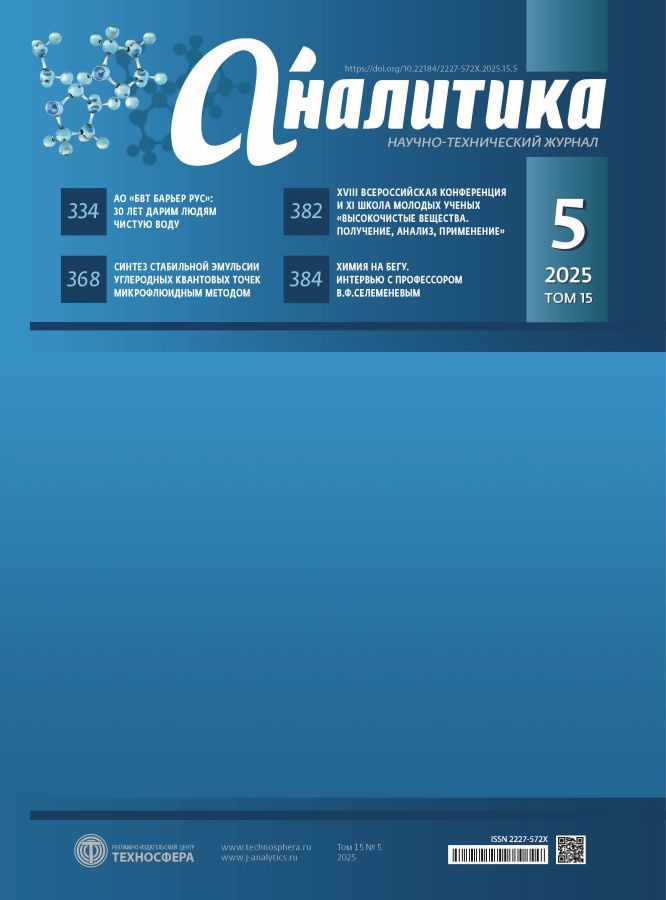Synthesis of a stable emulsion of carbon quantum dots by a microfluidic method
- Authors: Juraeva E.N.1,2, Korolev D.V.1,2,3
-
Affiliations:
- Almazov National Medical Research Center of the Ministry of Health of the Russian Federation
- Federal State Budgetary Educational Institution of Higher Education First Saint Petersburg State Medical University named after Academician I. P. Pavlov of the Ministry of Health of the Russian Federation
- Federal State Autonomous Educational Institution of Higher Education "St. Petersburg State Electrotechnical University "LETI" named after V. I. Ulyanov (Lenin)"
- Issue: Vol 15, No 5 (2025)
- Pages: 368-374
- Section: Analytical Methods and Instruments
- URL: https://journals.eco-vector.com/2227-572X/article/view/695465
- DOI: https://doi.org/10.22184/2227-572X.2025.15.5.368.374
- ID: 695465
Cite item
Abstract
The properties, features and areas of application of carbon quantum dots are described. Due to the wide range of radiation and ease of use, quantum dots are promising as labels for visualization of results in test systems. The choice of microfluidic technology for use in test systems is substantiated, its advantages over classical methods are discussed. The algorithm for manufacturing a microfluidic device (MFD) from polydimethylsiloxane by the soft lithography method is described in detail. The synthesis of a stable emulsion of carbon quantum dots is implemented. The optimal synthesis parameters are selected: speed and pressure. The resulting emulsions are analyzed, conclusions are made about the possibility of their use in test systems.
Full Text
About the authors
Elena Nikolaevna Juraeva
Almazov National Medical Research Center of the Ministry of Health of the Russian Federation; Federal State Budgetary Educational Institution of Higher Education First Saint Petersburg State Medical University named after Academician I. P. Pavlov of the Ministry of Health of the Russian Federation
Email: dimon@cardioprotect.spb.ru
Junior Researcher
Russian Federation, 197341, Saint Petersburg, Akkuratova st., 2; 197022, Saint Petersburg, Leo Tolstoy St., 6–8Dmitry Vladimirovich Korolev
Almazov National Medical Research Center of the Ministry of Health of the Russian Federation; Federal State Budgetary Educational Institution of Higher Education First Saint Petersburg State Medical University named after Academician I. P. Pavlov of the Ministry of Health of the Russian Federation; Federal State Autonomous Educational Institution of Higher Education "St. Petersburg State Electrotechnical University "LETI" named after V. I. Ulyanov (Lenin)"
Author for correspondence.
Email: dimon@cardioprotect.spb.ru
ORCID iD: 0000-0003-2848-3035
Doctor of Chemical Sciences, Head of the Nanotechnology Research Laboratory, Junior Researcher, Research interests: medicinal chemistry, solid state chemistry
Russian Federation, 197341, Saint Petersburg, Akkuratova st., 2; 197022, Saint Petersburg, Leo Tolstoy St., 6–8; St. PetersburgReferences
- Cui J., Panfil Y. E., Koley S. et al. Colloidal quantum dot molecules manifesting quantum coupling at room temperature. Nat. Commun. 2019;10:5401. https://doi.org/10.1038/s41467-019-13349-1.
- Yashin K. D., Osipovich V. S., Pitsuk S. E. Structure of the nanocrystals of cadmium selenit received by the method of colloid chemistry for the use in medical diagnostics. Rep BGUIR. 2007;5:74–79.
- Мусихин С. Ф., Александрова О. А., Лучинин В. В., Максимов А. И., Мошников В. А. Полупроводниковые коллоидные наночастицы в биологии и медицине. Биотехносфера. 2012;5–6:23–24. Musikhin S. F., Aleksandrova O. A., Luchinin V. V., Maksimov A. I., Moshnikov V. A. Semiconductor colloidal nanoparticles in biology and medicine. Biotekhnosfera=Biotechnosphere. 2012;5–6:23–24 (In Russ).
- Pleskova S., Mikheeva E., Gornostaeva E. Using of Quantum Dots in Biology and Medicine. Cellular and Molecular Toxicology of Nanoparticles. 2018;8:2532–2543.
- Du Y., Guo S. Chemically doped fluorescent carbon and graphene quantum dots for bioimaging, sensor, catalytic and photoelectronic applications. Nanoscale. 2016;3:323–334.
- Zhu S. The photoluminescence mechanism in carbon dots (graphene quantum dots, carbon nanodots, and polymer dots): current state and future perspective. Nano Research. Tsinghua University Press. 2015;8:355–381.
- Meixiu L., Tao C., Gooding Justin J. A Review of Carbon and Graphene Quantum Dots for Sensing. ACS Sensors. 2019;4:1732–1748.
- Lim S., Shen W., Gao Z. Q. Carbon quantum dots and their applications. Chem. Soc. Rev. 2015;44:362–381.
- Alam S. M., Arundithi A., Lin H. Revealing the tunable photoluminescence properties of graphene quantum dots. Journal of Materials Chemistry. 2014;34:6954–6960.
- Hsiung S., Cheng-Tso C. Micro-droplet formation utilizing microfluidic flow focusing and controllable moving-wall chopping techniques. Journal of Micromechanics and Microengineering. 2006;16(11):2403–2410.
- Кухтевич И. В., Посмитная Я. С., Белоусов К. И., Букатин А. Е. Принципы, технологии и устройства «капельной» микрофлюидики. Ч. 1 (Обзор). Научное Приборостроение. 2015;25:65–85. Kukhtevich I. V., Posmitnaya Ya.S., Belousov K. I., Bukatin A. E. Principles, technologies and devices of “droplet” microfluidics. Part 1 (Review). Nauchnoye Priborostroyeniye=Scientific Instrument Engineering. 2015;25:65–85 (In Russ.).
- Reyes D. R., Iossifidis D., Auroux P. A. Micro Total Analysis Systems. 1. Introduction, Theory, and Technology. Anal. Chem. 2002;74:2623–2636.
- Janasek D., Franzke J., Manz A. Scaling and the Design of Miniaturized Chemical Analysis Systems. Nature. 2006; 442:374–380.
- Squires T. M., Quake S. R. Microfluidics-Fluid Physics at the Nanoliter. Scale. Rev. Mod. Phys. 2005;77:977–1026.
- Marre S., Jensen K. F. Synthesis of Micro and Nanostructures in Microfluidic Systems. Chem. Soc. Rev. 2010;39:1183–1202.
- Ren K., Zhou J., Wu H. Materials for Microfluidic Chip Fabrication. Accounts of Chemical Research. 2012;46:1–11.
Supplementary files












